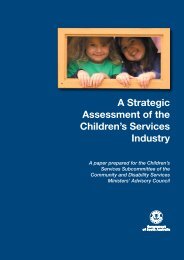Global Study On Child Poverty And Disparities (PDF) - Social Policy ...
Global Study On Child Poverty And Disparities (PDF) - Social Policy ...
Global Study On Child Poverty And Disparities (PDF) - Social Policy ...
Create successful ePaper yourself
Turn your PDF publications into a flip-book with our unique Google optimized e-Paper software.
Table 1.4: Economic activity, Vanuatu, 2006 (Population 15 years and over)<br />
Activity Number %<br />
Wages and salaries, full time 20,315 16.0<br />
Wages and salaries, part time 3,201 2.5<br />
Own business 2,813 2.2<br />
Selling products 6,361 5.0<br />
Own household consumption 47,765 37.6<br />
Unemployed 12, 819 10.1<br />
Other 33,651 26.5<br />
Total 126,926 100.0<br />
Sources: National Statistics Office; ADB, UNDP and GoV 2006.<br />
The 2006 survey also found that around 61 per<br />
cent of wage and salary earners lived in urban<br />
areas (49 per cent in Port Vila). Wage and salary<br />
employment increases by age, and peaks at<br />
around 22 per cent of those age 40 to 44 years.<br />
Wage and salary income is highest in Port Vila at<br />
around 196,000 vatu per capita per year in 2006,<br />
compared to 96,000 vatu in Luganville and 22,000<br />
vatu in rural areas. In the rural areas of Shefa<br />
Province – where Port Vila is located – it is 47,460<br />
vatu per person, more than twice as much as in<br />
any other rural province.<br />
As shown in Figure 1.6, wages and salaries<br />
account for 80 per cent of total household income<br />
in Port Vila and 57 per cent in Luganville, but<br />
for much lower proportions in rural areas. Ownaccount<br />
production is broadly similar in most rural<br />
areas, but much less significant in urban areas,<br />
while agriculture, fishing and handicrafts are most<br />
significant in Malampa, Sanma and Penama.<br />
Figure 1.6: Per capita annual household income<br />
by source and location, 2006 (Thousands of vatu)<br />
Wages and Salaries<br />
Other cash income<br />
Income in-kind<br />
Agriculture, Fish, Handicrafts<br />
Own production<br />
Gifts<br />
300,000<br />
250,000<br />
200,000<br />
150,000<br />
100,000<br />
50,000<br />
0 Torba Tafea Shefa Malampa Sanma Luganville Penama Port Vanuatu<br />
Vila<br />
Source: Based on data from ADB, UNDP and GOV 2006 and<br />
VNSO.<br />
Not all employed persons escape living in poverty.<br />
The working poor exist in Vanuatu; 5 7.7 per cent<br />
5 The number of working poor is calculated by estimating the number of employed persons<br />
living in a household with incomes below the poverty line as a proportion of total employment.<br />
of employed people living in rural areas and<br />
14.3 per cent of employed people living in urban<br />
areas were found to lack decent employment,<br />
with the income earned from employment or<br />
from subsistence being insufficient to lift their<br />
families out of poverty (GoV/UNDP, 2010) This<br />
suggests that employment, including subsistence<br />
gardening, provides a reasonable income for<br />
many rural households. <strong>On</strong> the other hand, a<br />
higher proportion of urban households, many of<br />
which are not able to supplement their formalsector<br />
employment with subsistence production,<br />
find it harder to meet their basic needs.<br />
Family and youth unemployment<br />
Unemployment is a major predictor of who is poor<br />
and who is not, particularly in urban areas. Of all<br />
unemployed people in Port Vila, 38 per cent are<br />
living below the Basic Needs <strong>Poverty</strong> Line. In this<br />
group, 27 per cent have domestic duties, 41 per<br />
cent are full-time students, and the remaining 32<br />
per cent reported ‘other’ main duties (ADB 2009,<br />
p.109). Adult unemployment in urban households<br />
can seriously affect children living in these<br />
households.<br />
Approximately three-quarters of the population<br />
lives in rural areas outside the two main urban<br />
centres; however, the degree of urbanisation is<br />
changing, with considerable movement from rural<br />
to urban areas, especially to Port Vila, whose<br />
population increased by 50 per cent between<br />
1999 and 2009, a rate of increase nearly twice<br />
the national average (Figure 1.7). It is projected<br />
that by 2020 Port Vila’s population will be as<br />
high at 60,000, many of whom will be young<br />
and unemployed (ADB 2009, p. 12). These<br />
changes place significant pressures on housing,<br />
infrastructure and services in Port Vila.<br />
24
















